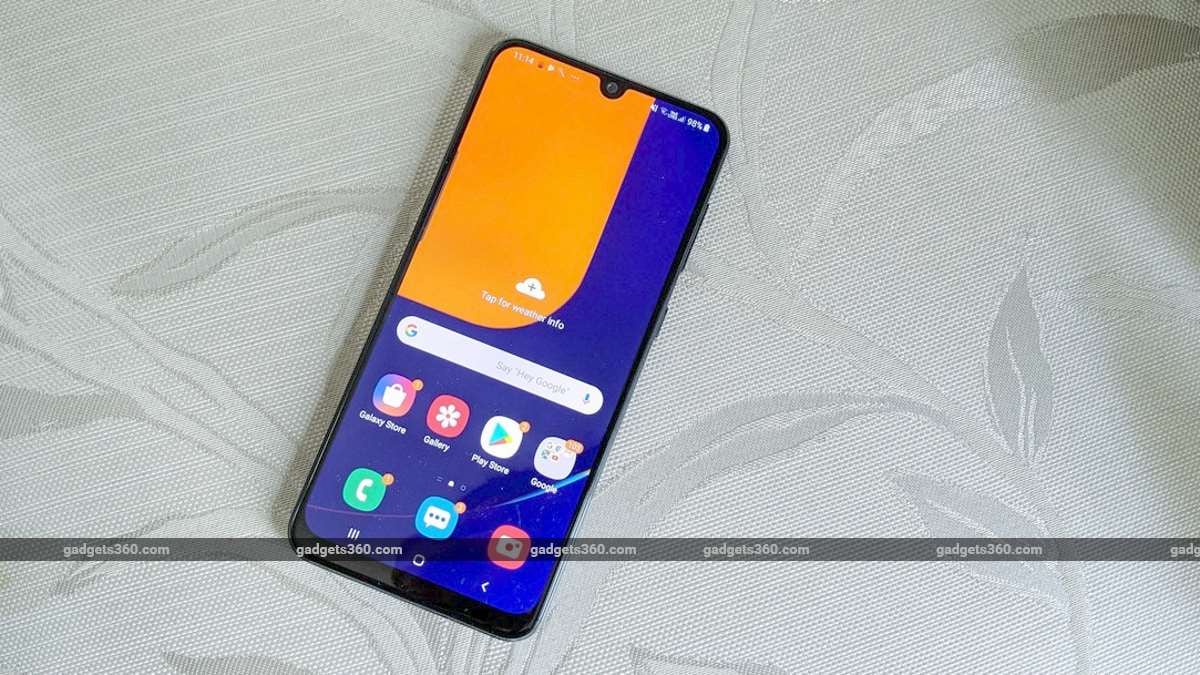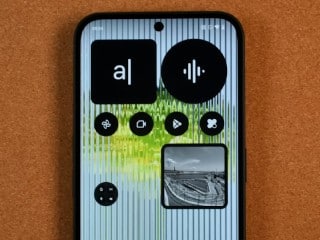- Home
- Mobiles
- Mobiles Reviews
- Samsung Galaxy A50s Review
Samsung Galaxy A50s Review
The Korean giant is hoping to stay competitive with a refreshed design and upgraded cameras.

The Samsung Galaxy A50s is a slight update over the Galaxy A50 launched earlier this year
We began this year with an avalanche of affordable Galaxy M-series and A-series smartphones from Samsung as part of the company's strategy to fight Xiaomi, Realme, and others on their terms. Samsung addressed pretty much every strategic price point between Rs. 8,000 and Rs. 20,000 in a very short span of time, sometimes with multiple options thanks to the sheer number of models and variants that were launched. It's been a while now since that rush of launches, and Samsung's competitors have all refreshed their slates, so it was inevitable that we'd see a few updated models from the Korean giant.
The brand new Samsung Galaxy A50s is priced starting at Rs. 22,999, which is a slight bump up in cost compared to the Galaxy A50 (Review). It joins the party shortly after the high-profile Redmi K20 (Review) was launched, and a few other flagship-grade phones have seen price cuts that place them in this segment as well. Which of these phones should you go for, with a budget of around Rs. 25,000? We review the Samsung Galaxy A50s to find out.
Samsung Galaxy A50s design
Not much is new in terms of the look and feel of the Samsung Galaxy A50s. When we reviewed the Galaxy M20 (Review), one of the first of Samsung's aggressive push, we commented on how generic it felt and how it broke from the company's previous designs. Similarly, the Galaxy A50s could easily be mistaken for any of a number of phones from today's major brands, no matter which angle you look at it from.
The front of this phone is pretty much all screen, with a small camera notch at the top (Samsung calls this design 'Infinity-U'). The screen corners are rounded, and there's a fairly thick chin while the sides and top borders are much narrower. The edges are very slightly curved, and we note with interest that this is one of the few phones we've reviewed of late that did not arrive with a plastic screen guard already stuck on, which we don't mind, and even appreciate.
On the rear, we have the one touch of personality that Samsung has decided to show off – an off-centre geometric pattern of criss-crossing lines with different shades of colour in each segment. There are three options: Prism Crush Black, Prism Crush White, and Prism Crush Violet – our review unit is the black version, but the colours on the back are various shades of grey.
Thankfully, this design isn't quite as prone to picking up smudges and fingerprints as the mirror-like finish of the Galaxy A50, but it still needs to be wiped several times per day to stay looking good. There is still a very slight prismatic effect under some kinds of light, though is far more subtle than the psychedelic reflections we saw on this phone's predecessor.
There's a USB Type-C port on the bottom, along with a 3.5mm audio socket and a single speaker. The tray on the left has slots for two Nano-SIMs as well as a microSD card. The power and volume buttons are all on the right, and the top is blank.
At 166g and only 7.7mm thick, the Galaxy A50s is surprisingly easy to handle and live with. You might have to stretch a little to reach the top of the 6.4-inch screen, but otherwise we had no complaints. Construction quality is also pretty good, though this phone still feels plasticky and not very premium. There's also no mention of what kind of glass has been used for the screen.
We didn't see scuffs or scratches on the frame or rear panel during our review period, but we'd use this phone with a plastic case. Thankfully, one is included in the retail box. Samsung also throws in a 10W charger, a USB Type-C cable, a 3.5mm wired headset, a SIM eject tool, and a quick start guide.
![]() Prismatic patterns of light can be seen at some angles
Prismatic patterns of light can be seen at some angles
Samsung Galaxy A50s specifications and software
The first thing you'll notice about this phone when you turn it on is the crisp, bright Super AMOLED screen. It measures 6.4 inches across, but that's cropped to about 6.2 inches if you measure using the rounded corners. The resolution is full-HD+ at 1080x2340. There's a notch at the top for the front camera, and an integrated fingerprint sensor which is positioned conveniently.
Samsung has used its own octa-core Exynos 9611 processor, which appears to be a minor update to the Exynos 9610 featured in the Galaxy A50. You get four 1.74GHz ARM Cortex-A53 cores and four 2.3GHz Cortex-A73 cores, plus Mali-G72 graphics. This chip has the same CPU, GPU, and LTE capabilities as its predecessor but supports higher camera resolutions.
That brings us to one big new feature of this phone, its 48-megapixel f/2 primary rear camera. It's joined by an 8-megapixel f/2.2 wide-angle camera and a 5-megapixel depth sensor. The front-facing camera has also been upgraded with a 32-megapixel resolution and f/2 aperture.
There are two variants of this phone, but both have 128GB of storage. The only difference is that you get either 4GB for Rs. 22,999 or 6GB of RAM for Rs. 24,999. This is similar to how Samsung offered the Galaxy A50, and we think it's quite unnecessary to have two options that are so similar. You're unlikely to see much difference unless you run lots of heavy apps and games.
The battery is fairly large at 4000mAh, and 15W fast charging is possible though you get a 10W charger in the box. Dual-band Wi-Fi 802.11ac, Bluetooth 5, GPS, NFC, and FM radio are all available.
![]() There's a USB Type-C port and a 3.5mm audio socket on the bottom
There's a USB Type-C port and a 3.5mm audio socket on the bottom
Our unit came with version 1.5 of Samsung's One UI software, running on top of Android 9 with the August 2019 security update. One UI is designed primarily for big-screen phones and while it does look crisp and modern, we aren't fans of the oversized icons and wide spacing everywhere. Thankfully you can adjust the size and density of the home screens and app drawer through their settings.
There's a lot of whitespace in menus and it all feels like the big screen isn't being used optimally, especially in the notifications shade and Settings app where a lot of scrolling is needed. That said, the ability to pull menus and controls down so that even the topmost lines are within tapping reach is very welcome. There are also loads of features tucked away, including a Secure Folder, Samsung Pay, a Kid's space, Night Mode, floating apps, and Dual Messenger app cloning with independent contact lists.
Long-pressing the power button on the right now calls up the Bixby voice assistant. To shut your phone down, there's a little on-screen power button in the quick toggles area that you reveal by swiping downwards from the top of the screen. There's also a Bixby Home screen to the left of the first home screen with some useful panels such as sports scores and reminders, but also plenty of promotional content.
Bixby Routines let you chain multiple commands with simple "if…then" conditions. For example, you can tell the Galaxy A50s to change its Wi-Fi and Bluetooth status, sound profile, display customisations, lock screen shortcuts, and accessibility settings and also have it execute specific actions such as opening a website or sending an SMS. All these things can be triggered in one go when you leave or enter a location, connect an accessory, open a specific app, receive a phone call, and/ or pair with a specific Bluetooth device.
The Super AMOLED panel allows for an ambient display, though by default the phone is set to require a single tap while the phone is in standby to see the time and status icons. You can set it to remain visible all the time or only between specified times.
You also have lots of control over what content is visible on the lock screen, plus a selection of animated wallpapers or collections of images that will be cycled. Lock Screen Stories are snippets of content, some of it advertising, that will appear each time you wake your phone from sleep. This can be disabled during the initial Android setup process.
Samsung has also decided to implement its Edge Panels feature, which we've previously seen only on higher-end phones with curved glass sides. This thin visible tab can be positioned on either side of the screen, and you swipe inwards on it to bring up one or more vertical strips containing shortcuts to contacts or apps, or miniature tools, or content feeds. More edge panels can be downloaded through Samsung's Galaxy Store.
There are only a few preloaded apps: Facebook, Netflix, OneDrive, and Samsung's Galaxy Store and Game Launcher. As we were setting up this phone, we were informed that apps will be “put to sleep” if they aren't used for three days or more, which means they will not refresh their content and you might not receive some notifications. This can be disabled in the battery settings, but it's still worth noting that the default setting is unusual and could cause some unexpected notification delays.
![]() The Samsung Galaxy A50s lets you use two Nano-SIMs and a microSD card at the same time
The Samsung Galaxy A50s lets you use two Nano-SIMs and a microSD card at the same time
Samsung Galaxy A50s performance and battery life
We were curious to see what Samsung has changed with the Galaxy A50s compared to the Galaxy A50 in order to justify its price increase. We found that there really isn't much that's new as far as general usage goes. Our experiences testing the 6GB RAM variant with day-to-day usage were pleasant enough. Face recognition and the fingerprint sensor work well, but aren't especially quick.
We did feel a bit of unexpected sluggishness in general use at first, but soon realised that the default animated lock screen wallpaper was the problem. We also found a ‘Reduce Animations' toggle in the Advanced section of the Settings app, which made a huge difference to responsiveness. OneUI might not be very cluttered, but it could use some performance optimisations on this phone.
The 6.4-inch full-HD+ Super AMOLED screen is one of Samsung's signature advantages. It's bright and punchy without being oversaturated, and viewing angles are excellent. We found the tone a little too warm, but in order to adjust this we had to switch colour modes from Natural to Vivid, which we found put a bit too much strain on our eyes. Other than that, this is a great display for watching movies and playing games on.
The single speaker is predictably not great for music but does well enough if you want to listen to dialogue in video. The bundled headset's earbuds are made of hard plastic with no rubber tips and is not only uncomfortably but also barely adequate for anything more than voice calls.
AnTuTu gave us a score of 1,55,120 while Geekbench 4's single- and multi-core tests returned 1,684 and 5,468 respectively. We also got 1,415 in 3DMark Slingshot Extreme and 15,450 in 3DMark Ice Storm Unlimited. GFXBench's Manhattan 3.1 and T-rex tests ran at 14fps and 40fps respectively.
These scores show that the Exynos 9611 processor trades blows with the Exynos 9610 in the older Galaxy A50, but generally comes out slightly ahead. However, compared to the Redmi K20, which is also priced at around this level and features the Qualcomm Snapdragon 730 processor, the performance of the Galaxy A50s is significantly weaker.
PUBG Mobile ran at its High settings by default, but after about 15 minutes of playing we found the upper half of the rear of this phone had become noticeably warm. It wasn't too bad at first, but it did become uncomfortable after a long match. Asphalt 9: Legends also ran very well, and didn't seem to make the Galaxy A50s as warm.
The Galaxy A50s delivers solid day-long battery life, but curiously the Galaxy A50 did better when we reviewed it. We could get through a full day of relatively heavy usage, including lots of photo and video recording, a few rounds of popular games, and constant Web browsing with about 25 percent left by late night. Our HD video loop test ran for 13 hours, 16 minutes which is also less than what the previous model delivered. Thankfully charging is quick, and we got from zero to about 30 percent in half an hour.
![]() The power and volume buttons are on the right of the Samsung Galaxy A50s
The power and volume buttons are on the right of the Samsung Galaxy A50s
Samsung Galaxy A50s cameras
As stated earlier, the primary new feature of this phone is its 48-megapixel rear camera. Just like most other companies, you get lower resolution photos by default but can switch to the full 48 megapixels. Unfortunately, this option is buried in a photo aspect ratio menu – you have to find the tiny icon labelled 4:3H (for High resolution).
The camera app UI is fairly busy with four rows of controls with icons or text labels above the main shutter release. You switch between the standard and wide-angle cameras with a simple toggle slider but it can be easy to lose track of which one is active. Interestingly you can hide some of the main camera modes, such as Super Slow-mo, Food, or Panorama, and you can reorder the ones you do want to keep in the carousel. This is useful, since there are so many options.
![]()
![]() Tap to see full-sized Samsung Galaxy A50s camera samples (above: standard; below: wide-angle)
Tap to see full-sized Samsung Galaxy A50s camera samples (above: standard; below: wide-angle)
Night Mode is something we've now come to expect on smartphones, and works by combining multiple exposures. There's also a Scene Optimiser toggle but one thing that's conspicuous by its absence is any mention of AI to help the camera choose settings based on subjects and shooting conditions that it detects.
The primary rear camera took some great shots when there was plenty of light in the daytime. Textures were crisp, and there was natural depth-of-field in close-up shots even without the Live Focus effect. Colours were vibrant and there was very good detail within the focus area of most shots. The Galaxy A50s was also quick to lock focus.
Live Focus mode didn't always get shots perfect, and sometimes resulted in a loss of detail. You can adjust the intensity of the background blur and also add motion or a spot colour effect after taking a shot, but you can't adjust the focus point.
Unfortunately, the wide-angle camera produced jarringly skewed photos with a highly unrealistic perspective. Subjects in the centre of the frame, such as people, appeared squashed, while there was severe barrel distortion at the edges.
We were also somewhat underwhelmed with all the shots we took at night. The Galaxy A50s often took a while to lock focus, or failed to do so. There was noticeable shutter lag, and photo quality was just about okay if we didn't zoom in to check details at all. The wide-angle camera also delivered much poorer performance at night. The Night Mode did improve the brightness and tone of wide shots a little but didn't do much for closeups, and the results were sometimes blotchy and unusable.
![]()
![]()
![]()
![]() Tap to see full-sized Samsung Galaxy A50s camera samples
Tap to see full-sized Samsung Galaxy A50s camera samples
The front-facing 32-megapixel camera also takes binned shots by default, with a “4:3H” option if you want to use the full resolution. Beautification is set to Auto by default, and Live Focus is available, though without the benefit of a hardware depth sensor. Selfies came out looking okay, though we preferred disabling beautification.
Video recording goes up to 4K 30fps with the primary rear camera and the front one, but the wide-angle toggle disappears when this resolution is selected and you'll see a message saying that stabilisation is not supported. There's also a 10-minute recording limit. You can only switch between cameras before you start shooting a clip, not while recording is in progress.
Full-HD video is decent, and you can see the effect of electronic stabilisation, but there's still some jitter and focus hunting. At 4K, it's best to stay still while filming, but video is definitely crisp and detailed. The wide-angle camera takes rather low-quality full-HD video. At night, detail suffers quite a lot and hand movements cause a lot of shakiness. It's best to avoid using the wide-angle camera for video in low light altogether.
![]() The Samsung Galaxy A50s features a 48-megapixel primary rear camera
The Samsung Galaxy A50s features a 48-megapixel primary rear camera
Verdict
As far as specifications and the overall usage experience go, there isn't much difference at all between the Galaxy A50s and its predecessor, the Galaxy A50 (Review). There's nothing groundbreaking here, and nothing that really stands out for a sub-Rs. 25,000 phone today. That said, everything works well enough, and both the hardware and software feel highly polished.
The only thing that's really new is the 48-megapixel rear camera, which can deliver some very good shots in the daytime. Unfortunately the supporting ultra-wide camera is far from the best that we've seen, and this is now nearly a standard feature for mid-range Android smartphones. Low-light performance was disappointing across the board.
We can't help but compare this phone to Xiaomi's Redmi K20 (Review), which sells for less than the Galaxy A50s but offers a superior processor, a notch-less screen, better battery life, better material quality, and arguably better cameras. There are also some last-gen flagship-class phones that have fallen in price, such as the Asus ZenFone 5z (Review), to consider.
If you have made up your mind to buy this phone, you'll be perfectly happy with the lower priced variant which has 4GB of RAM. It would only make sense to spend Rs. 2,000 more if you're going to be running lots of heavy games or intend to use this phone for many years, in which case you'll probably be looking at more powerful options at this price level anyway.
Catch the latest from the Consumer Electronics Show on Gadgets 360, at our CES 2026 hub.
Related Stories
- Samsung Galaxy Unpacked 2025
- ChatGPT
- Redmi Note 14 Pro+
- iPhone 16
- Apple Vision Pro
- Oneplus 12
- OnePlus Nord CE 3 Lite 5G
- iPhone 13
- Xiaomi 14 Pro
- Oppo Find N3
- Tecno Spark Go (2023)
- Realme V30
- Best Phones Under 25000
- Samsung Galaxy S24 Series
- Cryptocurrency
- iQoo 12
- Samsung Galaxy S24 Ultra
- Giottus
- Samsung Galaxy Z Flip 5
- Apple 'Scary Fast'
- Housefull 5
- GoPro Hero 12 Black Review
- Invincible Season 2
- JioGlass
- HD Ready TV
- Laptop Under 50000
- Smartwatch Under 10000
- Latest Mobile Phones
- Compare Phones
- OPPO A6c
- Samsung Galaxy A07 5G
- Vivo Y500i
- OnePlus Turbo 6V
- OnePlus Turbo 6
- Itel Zeno 20 Max
- OPPO Reno 15 Pro Mini 5G
- Poco M8 Pro 5G
- Lenovo Yoga Slim 7x (2025)
- Lenovo Yoga Slim 7a
- Realme Pad 3
- OPPO Pad Air 5
- Garmin Quatix 8 Pro
- NoiseFit Pro 6R
- Haier H5E Series
- Acerpure Nitro Z Series 100-inch QLED TV
- Asus ROG Ally
- Nintendo Switch Lite
- Haier 1.6 Ton 5 Star Inverter Split AC (HSU19G-MZAID5BN-INV)
- Haier 1.6 Ton 5 Star Inverter Split AC (HSU19G-MZAIM5BN-INV)


















